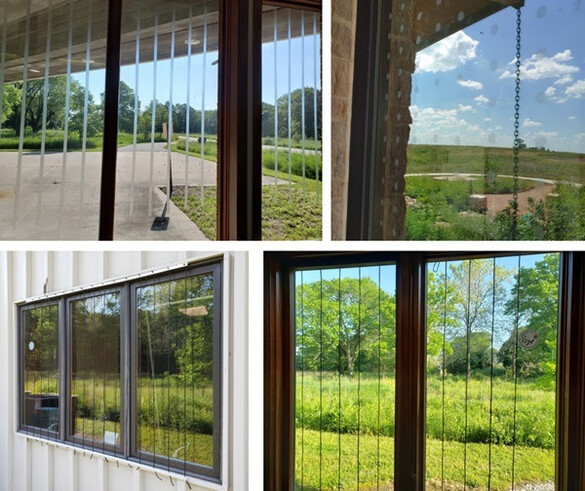Collisions with windows are the second largest human-related cause of mortality to North American birds, after outdoor and feral cats. Research has found that window collisions account for up to 1 billion bird deaths in North America each year, and occur at buildings of all sizes. You may have seen pictures of large numbers of birds killed by skyscrapers during migration, but because there are so many low-rises and residences, these smaller buildings actually account for 99% of bird window collisions, with each residence killing an average of 2 birds per year. Although many birds fly away after a collision, it’s estimated that over 50% of collisions are fatal.
While it is saddening to read these statistics, bird window collisions are preventable, and everybody can play a role in reducing this hazard to birds! Learn more at stopbirdcollisions.org.
Why do birds fly into windows?
Windows are invisible to birds, and since birds are used to flying through tight spaces and around obstacles, window and door frames don’t alert them to the presence of a window. Additionally, windows often reflect their surroundings, including trees and sky, which makes a window look like habitat to a bird. In some cases, if birds are frightened or being chased by predators, they see the habitat reflected in a window as an escape route and end up striking the glass. Collisions are most likely to occur during spring (April-May) and fall (August-October) migration when birds are moving through in large numbers, but can occur any time of year. Songbirds are especially susceptible to collisions because they are often found in shrubs and trees near buildings, and tend to make quick movements. Juvenile birds, just learning to fly and navigate the world, are also at increased risk.
Ways to reduce bird-window collisions
Bird Safe Glass
There are a number of strategies that help make windows visible to birds and reduce their likelihood of collision. One strategy is to use bird safe glass, which utilizes an ultraviolet pattern on the glass which is visible to birds but invisible to the human eye. Etched or patterned glass can also be used, but these markings are visible and may impede the view. It’s most cost-effective to include bird safe glass in the initial design/planning phase of a building, instead of needing to retro-fit later. Although it is highly effective, purchasing bird safe glass can be costly, especially at a large scale.
Window Treatments
Luckily, many other less expensive and reversible solutions exist. You may be familiar with the hawk decals people place on windows, these and other decals and stickers are intended to alert birds of the glass, but are only effective if they are dense enough that the birds can’t fly around them, which means 2-inch spacing. Ultraviolet tape or patterned decals are another effective strategy because many species of birds see UV light, but people do not. Even using tempera paint on windows can be an effective, fun, and attractive way to make birds aware of glass. Screens or netting placed on the outside of windows can help to make them more visible to birds and is a less dangerous surface to hit in the event that a bird does fly towards the window. Parachute cord curtains are another aesthetically pleasing option.
Some general tips to make these deterrents most effective are to:
- Place window treatments on the outside of the windows when possible to make sure they are visible to birds
- Make sure the spacing of decals, cord, tape, or paint is close enough that birds won’t try to fly through the treatments
- Use vertical patterns that are at least ¼ inch wide and no more than 4 inches apart
- Horizontal patterns that are at least ¼ inch wide and no more than 2 inches apart
- Use bright or light colors, because dark colors can be hard for the birds to see if the window reflects dark colors
- Try several options and see which is most effective at deterring birds in your situation, and which you prefer visually
Lights Out During Migration
More than 80% of North American migratory birds do so at night, and they can be attracted to or disoriented by building lights from as far as 3 miles away. In Iowa, you can reduce the risk of birds hitting windows during night time flights, or attracting them to other urban threats, by turning lights off from 11:00 pm to 6:00 am between April-May and August-October each year. This is especially important on nights when millions of birds are on the move.
Check out BirdCast to see nightly migration predictions and daily migration counts, and sign up for alerts of busy migration nights.
As birds continue to adapt to an ever more human-dominated world, helping to reduce the hazards they face is a great way to make sure our feathered neighbors survive and thrive. Please consider adding window treatments that help reduce bird window collisions at your home or place of work because every safe window helps!
Resource Round Up
- Learn how to make your windows visible to birds at stopbirdcollisions.org
- Do your part to keep lights out for birds
- Follow spring and fall bird migration with Birdcast
- Love birds? Check out this new bird watching resource to learn about how to get into birding, the best places to bird, and how to create a bird-friendly backyard landscape!

